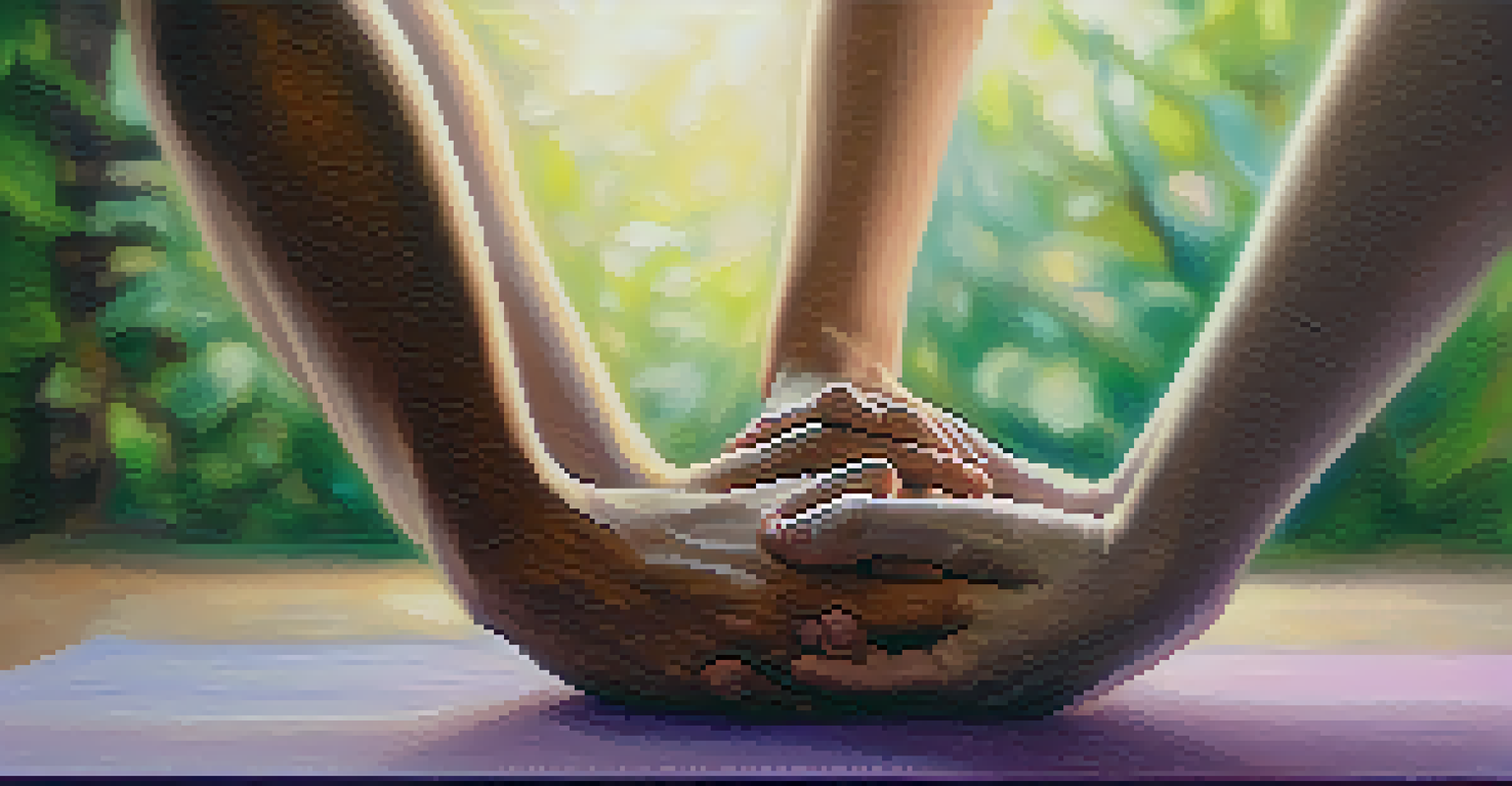Exploring Vulnerability in Partner Yoga Sessions Together

Understanding Vulnerability in Partner Yoga
Vulnerability is often viewed as a weakness, but in partner yoga, it becomes a strength that fosters deeper connections. When you practice alongside a partner, you open yourself up to trust, communication, and emotional sharing. This shared experience creates a safe space where both partners can explore their limits and fears together.
Vulnerability is the birthplace of innovation, creativity and change.
Imagine balancing in a pose like a tree, where one partner supports the other. Each wobble becomes an opportunity to communicate openly about feelings of fear or insecurity. This exchange not only enhances physical balance but also strengthens emotional bonds, allowing both individuals to grow together.
Through vulnerability, partners learn to see each other’s authentic selves, which can deepen their relationship. It encourages a spirit of cooperation and empathy, allowing each person to feel heard and understood, laying the groundwork for a healthier partnership both on and off the mat.
Creating a Safe Space for Vulnerability
A safe space is crucial for exploring vulnerability in partner yoga. This environment allows individuals to express their feelings without fear of judgment. Setting intentions before starting your session can help clarify what each partner hopes to achieve, whether it’s emotional growth or physical alignment.

Consider starting your practice with a brief conversation about boundaries and comfort levels. This practice not only builds trust but also helps partners understand each other’s needs. When both partners feel secure, they are more likely to engage in open dialogue throughout the session.
Vulnerability Strengthens Connections
In partner yoga, vulnerability fosters trust and emotional sharing, deepening the bond between partners.
Additionally, incorporating gentle touches or supportive poses can enhance this safe space. Simple gestures, like holding hands or guiding each other into a pose, reinforce connection and trust. As partners navigate the practice together, they cultivate an atmosphere of mutual respect and understanding.
The Role of Communication in Partner Yoga
Effective communication is the backbone of successful partner yoga sessions. It allows partners to articulate their needs and emotions, making the practice more meaningful. By openly sharing thoughts and feelings, partners can create a dialogue that enriches their experience on the mat.
The most important thing in communication is hearing what isn’t said.
During poses that require balance, partners can use verbal cues to guide each other. For example, one partner might say, 'I feel a little off-balance; can you help me stabilize?' This kind of communication not only improves the physical practice but also fosters emotional connection as both partners work together toward a common goal.
Moreover, discussing feelings after the session can further enhance understanding. Reflecting on what worked well and what was challenging opens the door for deeper conversations. These discussions can help partners grow not just in their yoga practice, but also in their relationship.
Building Trust Through Shared Experiences
Trust is fundamental in partner yoga, and it’s built through shared experiences. Engaging in challenging poses together allows partners to rely on one another, creating a bond of trust. Each time you support each other through a tough pose, you’re reinforcing that trust and nurturing your relationship.
Think of it like a trust fall; when one partner leans back, the other must catch them. This physical act symbolizes the emotional trust that partners place in each other. As both individuals navigate challenges, they become more attuned to each other’s strengths and weaknesses.
Safe Spaces Enhance Practice
Creating a safe environment allows partners to express their feelings freely, enhancing both their yoga practice and relationship.
Over time, these shared experiences create a foundation of trust that extends beyond the yoga mat. Partners learn to lean on each other in life’s challenges, knowing they have each other’s backs. This mutual support fosters a deeper emotional connection, enhancing the overall relationship.
Embracing Imperfection in Partner Yoga
Partner yoga invites you to embrace imperfection, which is a vital part of vulnerability. No one is perfect, and acknowledging this can lead to a more authentic practice. When you allow yourself to be imperfect, you create an environment where both partners can be real and open.
For instance, if a pose doesn’t go as planned, instead of feeling embarrassed, partners can laugh it off together. This light-hearted approach not only eases tension but also reinforces the idea that it’s okay to be vulnerable. It encourages both partners to celebrate their uniqueness rather than striving for an unrealistic ideal.
By accepting imperfections, partners can cultivate a sense of freedom in their practice. This acceptance spills over into their relationship, fostering a culture of support and understanding. Ultimately, embracing imperfection allows both partners to grow individually and together.
Mindfulness and Presence in Partner Yoga
Mindfulness plays an essential role in partner yoga, enhancing the experience of vulnerability. By being present in the moment, partners can connect on a deeper level, both physically and emotionally. Mindfulness encourages individuals to focus on their breath, movements, and feelings, creating a heightened awareness of each other.
During a session, partners can practice mindfulness by synchronizing their breath. As each partner inhales and exhales together, they create a rhythm that fosters connection. This shared breathing experience can help partners feel more aligned and present with one another, amplifying their emotional bond.
Trust Grows Through Shared Challenges
Engaging in challenging poses together builds trust and mutual support, enriching the partnership beyond the yoga mat.
Moreover, mindfulness helps partners tune into their own bodies and emotions. By being aware of their feelings, they can communicate more effectively, ensuring that both partners feel comfortable and supported. This practice of mindfulness not only enriches the yoga session but also strengthens the relationship.
The Long-Term Benefits of Vulnerability in Yoga
Engaging in partner yoga and exploring vulnerability can lead to significant long-term benefits. As partners continue to practice together, they develop stronger emotional connections and improved communication skills. These benefits can transcend the yoga mat, positively impacting their everyday interactions.
For instance, partners who practice vulnerability are often better equipped to handle conflicts. They learn to approach disagreements with empathy and understanding, knowing that open communication is key. This skill can lead to healthier resolutions and a more harmonious relationship overall.

Furthermore, the trust built through partner yoga can enhance feelings of safety and security within the partnership. When both individuals feel emotionally supported, they are more likely to take risks together, whether in their personal lives or in their relationship. This shared growth fosters a lasting bond that continues to thrive.